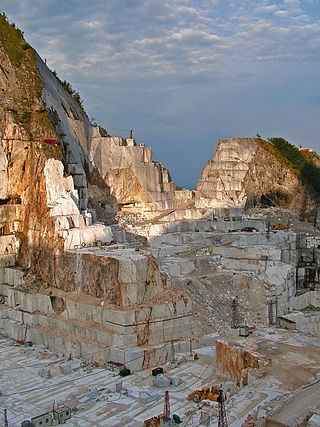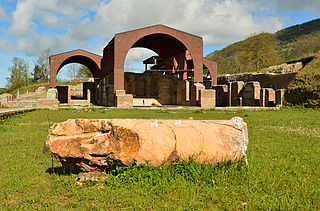
Ancient Roman architecture adopted the external language of classical ancient Greek architecture for the purposes of the ancient Romans, but was different from Greek buildings, becoming a new architectural style. The two styles are often considered one body of classical architecture. Roman architecture flourished in the Roman Republic and to an even greater extent under the Empire, when the great majority of surviving buildings were constructed. It used new materials, particularly Roman concrete, and newer technologies such as the arch and the dome to make buildings that were typically strong and well engineered. Large numbers remain in some form across the former empire, sometimes complete and still in use today.

Porphyry is any of various granites or igneous rocks with coarse-grained crystals such as feldspar or quartz dispersed in a fine-grained silicate-rich, generally aphanitic matrix or groundmass. In its non-geologic, traditional use, the term porphyry usually refers to the purple-red form of this stone, valued for its appearance, but other colours of decorative porphyry are also used such as "green", "black" and "grey".

Carrara marble, Luna marble to the Romans, is a type of white or blue-grey marble popular for use in sculpture and building decor. It has been quarried since Roman times in the mountains just outside the city of Carrara in the province of Massa and Carrara in the Lunigiana, the northernmost tip of modern-day Tuscany, Italy.

Karystos or Carystus is a small coastal town on the Greek island of Euboea. It has about 5,000 inhabitants. It lies 129 km south of Chalkis. From Athens it is accessible by ferry via Marmari from the port of Rafina. After the Greek war of independence, its urban plan was laid out by the renowned Bavarian civil engineer Bierbach, in the middle of the 19th century.
Carystus was a polis (city-state) on ancient Euboea. It was situated on the south coast of the island, at the foot of Mount Oche. It is mentioned by Homer in the Catalogue of Ships in the Iliad, as controlled by the Abantes. The name also appears in the Linear B tablets as "ka-ru-to". Thucydides writes that the town was founded by Dryopes. According to the legend, its name was derived from Carystus, the son of Cheiron.

Cosmatesque, or Cosmati, is a style of geometric decorative inlay stonework typical of the architecture of Medieval Italy, and especially of Rome and its surroundings. It was used most extensively for the decoration of church floors, but was also used to decorate church walls, pulpits, and bishop's thrones. The name derives from the Cosmati, the leading family workshop of craftsmen in Rome who created such geometrical marble decorations.

The Basilica Ulpia was an ancient Roman civic building located in the Forum of Trajan. The Basilica Ulpia separates the temple from the main courtyard in the Forum of Trajan with the Trajan's Column to the northwest. It was named after Roman emperor Trajan whose full name was Marcus Ulpius Traianus.

Massa is a town and comune in Tuscany, central Italy, the administrative centre of the province of Massa and Carrara. It is located in the Frigido River Valley, near the Alpi Apuane, 5 km (3 mi) from the Tyrrhenian Sea.

The Temple of Vespasian and Titus is located in Rome at the western end of the Roman Forum between the Temple of Concordia and the Temple of Saturn. It is dedicated to the deified Vespasian and his son, the deified Titus. It was begun by Titus in 79 after Vespasian's death and Titus's succession. Titus’ brother, Domitian, completed and dedicated the temple to Titus and Vespasian in approximately 87.

Forte dei Marmi is an Italian sea town and comune located in the province of Lucca, in northern Tuscany, overlooking the Ligurian Sea.

Docimium, Docimia or Docimeium was an ancient city of Phrygia, Asia Minor where there were famous marble quarries. The exact site of Docimium was a matter of some dispute until recently; it is now fixed at the modern Turkish town İscehisar, in Afyonkarahisar Province.

Luni is a comune (municipality) in the province of La Spezia, in the easternmost end of the Liguria region of northern Italy. It was founded by the Romans as Luna. It gives its name to Lunigiana, a region spanning eastern Liguria and northern Tuscany.
Belgian marble is the name given to limestone extracted in Wallonia, southern Belgium.

Verd antique, also called verde antique, marmor thessalicum, or Ophite, is a serpentinite breccia popular since ancient times as a decorative facing stone. It is a dark, dull green, white-mottled serpentine, mixed with calcite, dolomite, or magnesite, which takes a high polish. The term verd antique has been documented in English texts as early as 1745.

Pavonazzo marble, also known as Pavonazzetto, Docimaean marble or Synnadic marble, is a whitish marble originally from Docimium, or modern İscehisar, Turkey.

Naxian marble is a large-crystaled white marble which is quarried from the Cycladic Island of Naxos in Greece. It was among the most significant types of marble for ancient Greece and it continues to be quarried in modern times.

Montalto is a mountain located in Tuscany, Italy and part of the Apuan Alps range. Its highest peak is at roughly 913 meters above the sea level and it is also home of two villages, Retignano and Volegno, in the municipality of Stazzema, Province of Lucca.

No Cav is an Italian protest movement that arose in the early 21st century, criticising the Carrara marble quarries in the Apuan Alps.

Giallo antico is a precious yellow marble used first by the ancient Africans and later by the ancient Romans (which they called marmor numidicum It was one of the marbles most favoured by the Romans because of its beautiful yellow colour.

The Villa of Trajan was a palatial summer residence and hunting lodge of the ancient Roman Emperor Trajan, dating from the beginning of his reign. Its location, near the modern village of Arcinazzo, was, like many patrician villas, carefully chosen on high plateau at the foot of Monte Altuino and in a splendid wooded landscape to escape the summer heat of Rome. It is 2 km from the river Aniene which supplied Rome with water and on which Nero's villa at Subiaco is located about 12 km downstream. It occupies an area of about 5 hectares, much of which has yet to be excavated. Many fine room decorations have been recovered here, despite the mass robbing of expensive marbles in previous centuries.


















